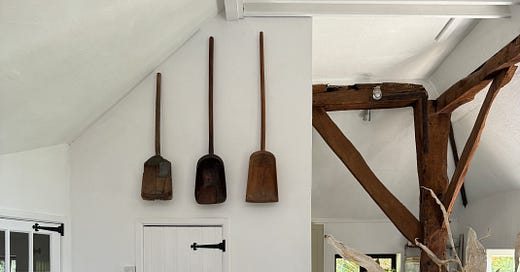How to Renovate: 5 Ways to Lighten Dark Oak Beams
Including one that requires no stripping at all, but looks just like pale oak!
As I’ve started yet another renovation (for any new folk here - this is our tenth), which I have promised you is my last, I was thinking it might be a good idea to start a new little ad hoc series on how to actually do things. I’m calling it: ‘How to Renovate’ and whenever I am in the throes of the next interior job on the list I’ll write a post to tell you what and how I’m doing it. Sound good? In the end I’ll create a tab for it on my page so that it forms a resource library for DIY. Btw - for the hort lovers I’ll be doing a similar thing for when I re-design and create our walled garden. I’ll also be starting another mini series soon on how to climb the property ladder and become mortgage-free, based on my 26 years of house buying and renovating. What do you think?
I’ve done a hell of a lot of stripping in my time. Not of the supposedly sexy naked variety, that would be tantamount to a form of torture, although I have been known to don a red g-string in the past, which had a little pocket on the front embroidered with the word ‘Tips’, but that’s another story. No, I mean the removal of paint and varnish. It’s one of those jobs I never ever want to start, but once I do I can’t stop and the sense of satisfaction once complete is like no other. It’s as if the item in question, be it a wooden floor, moulding, or architrave, has been finally set-free from the decades of bad clothing choices imposed upon it by countless previous owners with no fashion sense.
Our new home is a very old barn and piggery. Wherever you look there are centuries old monolithic oak beams, some of them right smack bang in the centre of a room, which adds enormous character, but which I now know can be a devil for fitting furniture around. Most of these Tudor relics, which we believe were hoisted into place near the end of the reign of Henry VII, were either left in their natural state, because why the hell would anyone bother staining the structure of a grain store and pig pen, or when it became a home in the 1970s, they were sandblasted during the conversion. Unfortunately, some clever twat between 1979 and today decided it was a smart move to stain most of the beams in the first mezzanine level with a colour not dissimilar to burnt toast. Thanks.
I held a little poll on my Midweek Musings the other day to find out whether any of you were actually interested in how I go about stripping these beams, or whether I was about to subject you all to the DIY equivalent of a feature-length slide show of a complete stranger’s verrucas. Astonishingly, 92% of you said you were interested. It would have been higher if my sausage fingers hadn’t twice accidentally hit the ‘no thanks I’d rather keep my clothes on’ button. So here goes, your wish is my command. Hopefully, mid-read you’re not regretting your decision!
There are more ways than one to skin a cat. Not that I have any intention, or desire to actually skin a cat, I mean, why would I? What did the poor cat do, other than possibly be typically nonchalant and aloof? Interestingly, the term came from a short story called The Money Diggers by Seba Smith in 1840. But, the point is it’s the same with stripping beams. Which method you choose depends on what they’re covered in and whether you can cope with the inordinate amount of mess and upheaval. Here are the various ways to do it, including the one that I’m using and another that involves no actual stripping at all and is utterly genius. Hallelujah I hear yo cry!





